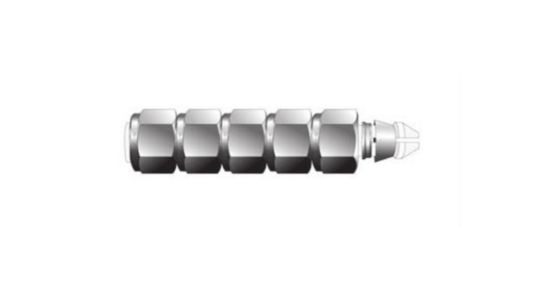Nut-Ferrule Set
Nut-Ferrule Set:
↪ This term refers to a combination of nuts and ferrules sold or used together as a set for specific types of fittings, typically compression fittings. It ensures compatibility between the components and simplifies procurement for users.↪ A Nut-Ferrule Set typically refers to a combination of nuts and ferrules used together in a specific type of fitting known as a compression fitting. Compression fittings are commonly used to create leak-tight connections in tubing systems, particularly in applications where it's essential to prevent fluid or gas leaks.
Nut
↪ The nut plays a crucial role in compressing the ferrules against the tubing or pipe, creating a seal and providing a secure connection.↪ In the context of a compression fitting, the nut is a typically hexagonal-shaped component. It is used to tighten and secure the fitting onto a mating threaded component, such as a pipe or tubing.
Ferrules
↪ Ferrules, in the context of compression fittings, are small, cylindrical components made of metal or plastic. They are placed around the outside of the tubing or pipe and are compressed by the nut during assembly.
Two types of ferrules in a compression fitting- ➬ ❲ Front ferrule ❳ and ➬ ❲ Back ferrule ❳
Compression Fitting Operation:↪ The tubing or pipe is inserted into the fitting body.
↪ The front ferrule is placed in front of the tubing.
↪ The back ferrule is placed behind the front ferrule.
↪ The nut is tightened onto the fitting body, compressing both ferrules against the tubing.
↪ This compression creates a secure, leak-tight seal, preventing the escape of fluids or gases.
Tube Outer Diameter (OD)
↪ Nut-ferrule sets are typically sized to match the outer diameter of the tubing they are intended to seal. 1/8", 3/16", 1/4", 5/16", 3/8", 1/2", 5/8", 3/4", 1", etc.↪ Metric sizes are also prevalent, such as: 4mm, 6mm, 8mm, 10mm, 12mm, 15mm, 18mm, 22mm, etc.
Fitting Sizes
↪ Metric sizes may include 6mm, 8mm, 10mm, 12mm, 15mm, 18mm, 22mm, etc.↪ The size of the compression fitting and the corresponding Nut-Ferrule Set should match the tubing size. 1/8", 1/4", 3/8", 1/2", 3/4", 1", etc.
Wall Thickness
↪ Nut-Ferrule Sets come in different wall thicknesses to accommodate variations in tubing wall thickness. This ensures a proper seal and secure connection. Typical wall thicknesses include standard, heavy, and extra-heavy.Fractional and Matric

Applications
↪ Nut-ferrule sets are widely used in various industries, including plumbing, hydraulic systems, pneumatic systems, and instrumentation.↪ They are particularly suitable for applications where a reliable, leak-tight connection is essential and where disassembly and reassembly are required for maintenance or modifications.
Spare Parts and Maintenance
↪ Nut-ferrule sets for compression fittings can vary depending on the industry, application, and regional standards.↪ Nut-Ferrule Sets are commonly kept in spare parts inventory by manufacturers, distributors, and maintenance departments to facilitate quick repairs or replacements.
↪ Proper selection of the Nut-Ferrule Set based on tubing size, material compatibility, and application requirements is crucial for ensuring the reliability and integrity of the compression fitting.
Material:
↪ Nut-Ferrule Sets are made from various materials, including brass, stainless steel, carbon steel, and plastics like PTFE (polytetrafluoroethylene).↪ The choice of material depends on factors such as compatibility with the fluid being conveyed, temperature, pressure, and corrosion resistance requirements.
Industry Standards:
↪ The choice of Nut-Ferrule Set size may also depend on specific application requirements, such as operating pressure, temperature range, fluid compatibility, and environmental conditions.↪ Depending on the industry and geographic location, specific standards may dictate the sizing and specifications of Nut-Ferrule Sets. For example, in the United States, standards from organizations like ASTM or SAE may apply, while in Europe, standards from organizations like DIN or ISO may be more prevalent.
